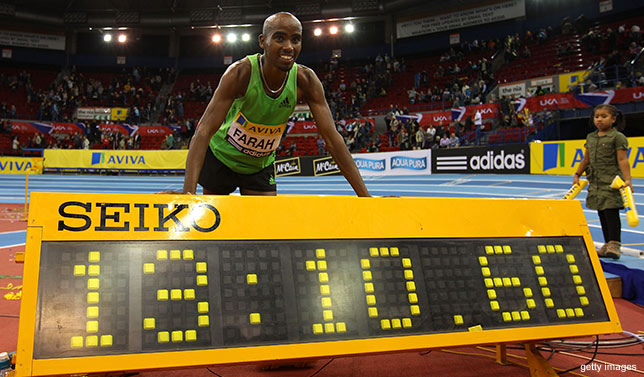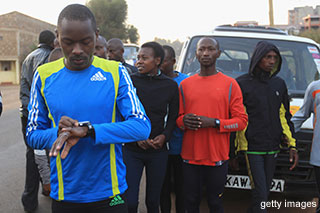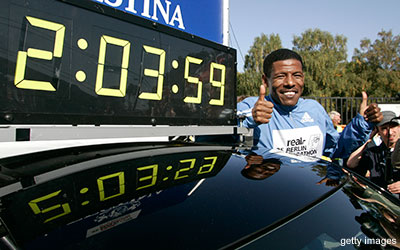
I'm training for the Chicago Marathon this October, and I've been known to run circles around my block at the end of a run, furiously monitoring my Garmin, willing it to hit the exact number of miles I set out to do that day. (4.97 miles -- oh no, that will not do. I must get to 5 miles!) While running for distance is certainly important when it comes to marathon training, I've been wondering recently: Are timed runs also part of an efficient training strategy?
If, like me, you've always run for miles rather than minutes, heed these pro tips to know when (and how!) to work them into your training plan. By the same token, if you're a lover of timed runs rather than mileage-based ones, you might consider expanding your repertoire, too.

MORE: How Long Do You Need to Train for a Marathon?
Timed Runs
The perks: "When running with a time goal [e.g., 50 minutes] there is more opportunity to run at an even pace than in distance-based runs [e.g., five miles]," says Jenny Hadfield, running coach and co-author of Running for Mortals and Marathoning for Mortal. Why? You won't be tempted to speed up towards the end to "get it over with," because unlike miles, you can't exactly make minutes go by faster. And since that "run fast, done fast” mentality can't exist with a timed-based run, it’s easier to run by effort level, which is important for building discipline so you can stick to your goal pace on race day (and not risk going out too hard/too fast and bonking).
What you're missing: If you’re not disciplined, you could end up skimping on mileage. “When running for time, one day you might be running 10-minute miles for a total of five miles in 50 minutes, but later in the week you're tired and stressed and run 11 to 12 minute miles on that 50-minute run,” says Terra Castro, LUNA sponsored pro triathlete-turned-coach. On the other hand, you could run too fast and end up overtraining (and possibly burnt out or injured).

How to maximize them: “The key is to not get greedy with the mileage and overdo it or underdo it, and then not get the most from your run and risk not being prepped for your race,” says Castro. Here’s how to master running by effort level -- and, in doing so, get the most from time-based runs: “Rate your level of intensity by how you feel on a scale of one to 10,” says Hadfield. “Then, run easy runs at a six to seven (a pace you could go at for a long time easily), moderate runs at seven-plus (a pace where you can hear your breathing, but not breathing hard), and speed drills at a nine (well outside comfort zone), says Hadfield.
MORE: 5 Cardio Myths You Need to Stop Believing
Distance-Based Runs
The perks: "Running by distance can help keep you accountable," says Castro. When you run by miles, you're guaranteed to get in the distance, even if it takes you a little longer on some days. And that's important, especially for long marathon training runs: “The long runs are the bread and butter of marathon training and it is key for mental and physical reasons to get in a percentage of the race distance,” says Hadfield.
What you're missing: In some cases, distance-based runs can compromise quality. "I'd rather have a runner get in a solid 20-minute run than to try to tackle an eight-mile run mid-week that would take them longer than it should [since on some days you’ll just be stronger/faster than on others],” says Hadfield. Since you’re logging more time on your feet, you’re more likely to fatigue and run with bad form -- a recipe for injury. Plus, if you're a newbie and a bit slower, you can easily get into an overtraining situation by logging too much time on your feet in an attempt to get in the miles, which can lead to injury, too, explains Hadfield.

How to maximize them: Keeps tabs on your stats. Since it’s tougher to maintain an even pace on distance-based runs naturally, use a GPS watch and keep an eye on it—it will show you your average or current pace (you can choose which one you want to see on the screen). “I use a Garmin Forerunner 220 to help me know where I am at on my runs, which is especially important on those frustrating days when your mind tells you, ‘I am exhausted, tired, can't do it,'" says Castro.
MORE: The Scary Health Risk All Runners Need to Know About
Moral of the Story
There's certainly a time and place for both timed and distance-based runs. Hadfield says that for her runners, the goal of mid-week moderate and easy runs is to train by quality rather than quantity, so she advises doing tempo and easy runs by time. Doing so can certainly improve your running form and help you become a better, faster runner in the long run.
But, as mentioned above, it’s important to do your long runs for distance so you’re guaranteed to get in the percentage of the race-distance miles (about 20 miles if you’re running 26.2) in your training, so you’ll be prepped for the big day.
If you just love running for exercise but aren't training for anything, there’s really no need to ever be doing distance-based runs, says Hadfield. But as with everything fitness related, it’s smart to mix things up from time to time and throwing in a distance-based run (if you usually run for time) is a great way to do just that!




